From established to growing applications spaces
Following my previous blog post ‘Understanding the jargon of LCOS SLMs‘ a few of my contacts have asked what they are used for. This blog will provide an overview of established and growing applications, going into detail for a selected few applications.
Recent publications using Meadowlark SLMs are available for all the below application spaces, please contact me if you would like some references.
Contribution credit: Dr Anna Linnenberger & Kipp Bauchert.
1. Applications – Overview
Established Applications Spaces
- Imaging in Scattering or Turbid Media
- Volumetric Imaging
- Optogenetics
- Fibre-based Optical Manipulation
- Point Spread Function (PSF) Engineering
- General Microscopy
- Holograpic Optical Tweezing (HOTs)
- Pulse Shaping
Growing Applications Spaces
- Optical Encryption
- Quantum Computing
- Advanced Imaging
- Optical Communications
- Quantum Optics
- Tamper Indication
- 3-D Printing
- Turbulence Simulation
2. Imaging in Turbid Media
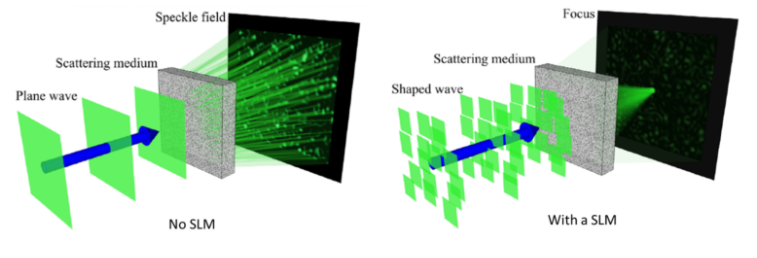
Overview
In recent years, much of the research on atmospheric turbulence correction is translating to biology, where biological systems introduce scattering and turbidity. For example, SLMs can be used in microscopes for deep tissue imaging. In order to maintain the structure of the excitation, the aberrations that the sources will encounter when passing through the sample must be pre-corrected.
Critical requirements:
For this market the SLM must offer high resolution, phase stability, and high speed switching. The SLM resolution determines the ability to correct for complex aberrations. High phase stability ensures temporally stable excitation which is important when imaging in scattering media with significant losses. High speed SLMs allow for real time adaptive optics.
Volumetric Imaging
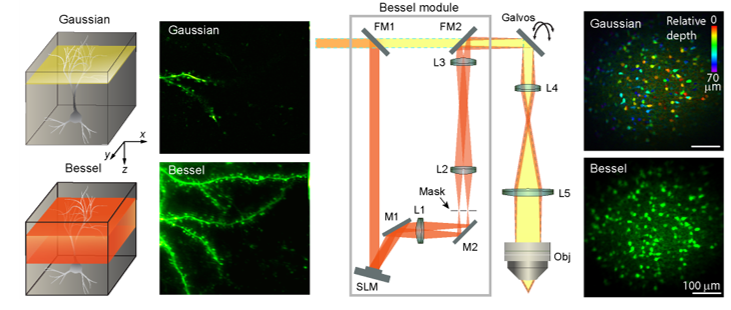
Overview
In order to understand biological functions at a system level it is necessary to image inter-connectivity of processes in real time. There are multiple approaches to volumetric imaging. Light sheet microscopy enables low intensity illumination across a plane of the sample such that large field of view imaging with minimised optical heating is achieved. Similarly scanning a Bessel beam throughout a volume enables compression of a volume of activity into a single plane for deep tissue, large field-of-view, high-speed imaging.
Critical requirements:
For this market the SLM must offer high resolution, and high speed switching. The SLM resolution allows the axial intensity of the illumination to be tuned to compensate for losses when imaging through highly scattering tissue. The switching speed of the SLM determines the rate at which the illumination can be scanned axially to extend the volume of imaging.
Optogenetics
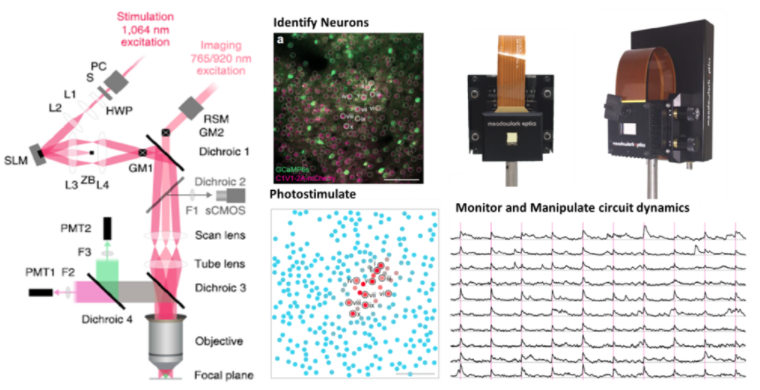
Overview:
SLMs can redirect light to hundreds of focal points with a programmable intensity in a 3D volume. In two-photon microscopes, LC-SLMs enable multisite 3D scan-less excitation for photoactivation, as well as high-speed volumetric imaging to record a volume of circuit activity. This combination provides neuroscientists with a toolbox for in vivo studies deep within the cortex to better understand the physical structure of neural circuits, the relationship of firing patterns, external stimuli and the resulting behavior, and how these processes are altered by neurological disease.
Critical requirements:
For this market, the SLM must provide high resolution, high phase stability, low losses, and high speed switching. The SLM resolution determines the field of view of the neural circuits that can be studied. High phase stability ensures temporally stable excitation. Low losses are important for studies of large scale neural circuits where light is divided among the number of neurons under study. High speed switching allows the programmability of the excitation to match rates of naturally occurring circuit dynamics.
Fibre-based Optical Manipulation
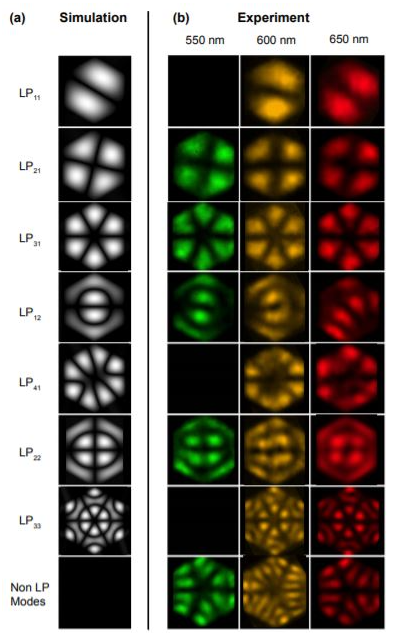
Overview:
Fibre optic communications have long been of interest, but more recently the technology is being coupled with SLMs for imaging deep in tissue where scattering would otherwise prevent optical techniques from being practical. Much research is focused on imaging through multi-mode fibres due to the small form factor that minimises damage to surrounding tissue. The challenge of imaging with multi-mode fibres is that manipulation of the fibre alters the phase error that the fibre introduces. High speed SLMs are used not only to remove the phases errors, but also to target excitation at the end of the fibre.
Critical requirements:
For this market, the SLM must provide high resolution, high phase stability, and high speed switching. The SLM resolution determines the ability to correct for aberrations introduced by the fibre and the ability to selectively redirect excitation after propagating through the fibre. High phase stability ensures temporally stable excitation and imaging. High speed allows for real time phase correction in as any handling of the fibre disrupts the phase of propagation.
PSF Engineering

Overview:
With the recent award of the Nobel Prize to Betzig and Moerner there has been a significant increase in awareness of point spread function (PSF) engineering. For this application the SLM is placed in the emission arm of a microscope to enable imaging of structures with a weak refractive index, super resolution imaging, and quantitative measurement of phase structures. Moerner demonstrated use of PSF engineering with a Meadowlark Optics SLM for super-resolution imaging and 3D localization of fluorescence emitters. PSF engineering has also been demonstrated as a non-mechanical solution to image a sample using multiple imaging modalities simultaneously. These modalities include: spiral phase imaging, dark field imaging, phase contrast imaging, differential interference contrast imaging, and extended depth of field imaging.
Critical requirements:
For this market it is important that the SLM minimise optical losses. PSF engineering uses a SLM to manipulate the wavefront in the emission path of the microscope. There is a lack of signal in fluorescence imaging without adding losses. Use of a SLM with a high fill factor minimises losses to diffraction. High resolution SLMs are ideal for creating the complex phase functions required for 3D localisation, and high speed allows for real time deep tissue super-resolution imaging.
Laser 2000 have a demo/loan system of the high speed P1920 at 1064nm (HSP1920-1064) which is a market leading product, details below:
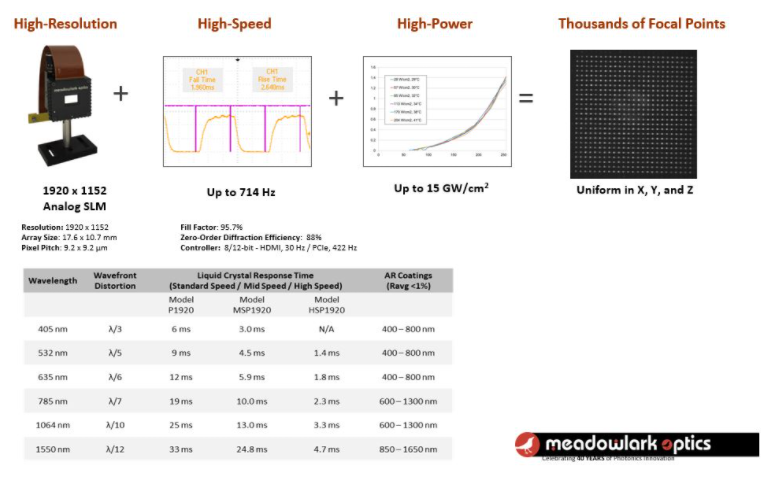
If you would like to book a free loan or have any questions just send me a direct message or an email [email protected] or give me a call on 01933 461 666.
Or contact us:































